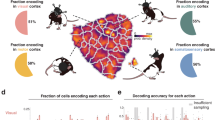A programmable Laboras apparatus, consisting of an automated behavioral reaction recording system, was used to record movement activity in male rats aged one, eight, and 16 months studied in groups of 12, with subsequent determination of the numbers of neuron bodies in layer V of the motor cortex in preparations stained by the Nissl method. Different age groups were found to have different numbers of neurons in the motor cortex. The greatest number was seen in animals aged eight months. Movement activity correlated with the number of neurons.
Similar content being viewed by others
References
I. N. Bogolepova and L. I. Malofeeva, “Developmental changes in the cytoarchitectonics of the speech motor fields of the frontal area of the cortex in males,” Zh. Anat. Gistopatol., 2, No. 1, 25–30 (2013).
T. V. Borzdova, Basic Statistical Analysis and Data Processing Using Microsoft Excel, IUST BGU Press, Minsk (2011).
T. A. Voronina, S. B. Seredenin, M. A. Yarkova, and M. V. Voronin, “Methodological recommendations for the preclinical study of the tranquilizing (anxiolytic) actions of medicines,” in: Handbook for Preclinical Studies of Medicines, Grif and K, Moscow (2012), Part 1, pp. 264–275.
D. A. Izliev, “Effects of microinjection of atropine into the motor cortex on the acquisition of a motor skill,” Zh. Vyssh. Nerv. Deyat., No. 3, 478–484 (1998).
M. E. Ioffe, “Cerebral mechanisms of the formation of new movements in learning: evolution of classical concepts,” Zh. Vyssh. Nerv. Deyat., 53, No. 1, 4–21 (2003).
N. M. Ipekchyan and S. A. Badalyan, “The primary motor and primary sensory cortex – two local cortical centers for the sensorimotor representation of the body,” Morfologiya, 142, No. 2, 7–12 (2013).
V. I. Nozdrin and G. A. P’yavchenko, “Experience in preclinical studies of dermatotropic drugs,” Tekhnol. Zhiv. Sist., 10, No. 8, 31–37 (2013).
G. A. P’yavchenko, “A method for assessing behavioral reactions in rodents,” in: Retinoidy, Retinoidy, Moscow (2014), No. 33, pp. 83–90.
K. N. Yarygin and V. N. Yarygin, “Neurogenesis in the central nervous system and the potential for regenerative neurology,” Zh. Nevrol. Psikhiat., No. 1, 4–13 (2012).
J. P. Donoghue and S. P. Wise, “The motor cortex of the rat: cytoarchitecture and microstimulation mapping,” J. Comp. Neurol., 212, 76–88 (1982).
J. A. Kleim, S. Barbay, and R. J. Nudo, “Functional reorganization of the rat motor cortex following motor skill learning,” J. Neurophysiol., 80, No. 6, 3321–3325 (1998).
G. Leisman and P. Koch, “Network of conscious experience: computational neuroscience in understanding life, death, and consciousness,” Rev. Neurosci., 20, No. 3–4, 154–176 (2009).
J. A. Markham and W. T. Greenough, “Experience-driven brain plasticity: beyond the synapse,” Neuron Glia Biol., 1, No. 4, 351–363 (2004).
G. Paxinos and C. Watson, The Rat Brain Atlas in Stereotaxic Coordinates, Academic Press, New York (1998), 4th ed.
J. B. Smith, T. M. Mowery, and K. D. Alloway, “Thalamic POm projections to the dorsolateral striatum of rats: potential pathway of mediating stimulus-response associations for sensorimotor habits,” J. Neurophysiol., 108, No. 1, 160–174 (2012).
A. L. Tierney and . A. Nelson III, “Brain development and the role of experience in the early years,” Zero Three, 30, No. 2, 9–13 (2009).
R. Viaro, M. Bundri, P. Parmiani, and G. Franchi, “Adaptive changes in the motor cortex during and after long-term forelimb immobilization in adult rats,” J. Physiol., 592, No. 10, 2137–2152 (2014).
Author information
Authors and Affiliations
Corresponding author
Additional information
Translated from Morfologiya, Vol. 147, No. 3, pp. 7–10, May–June, 2015.
Rights and permissions
About this article
Cite this article
P’yavchenko, G.A., Shmarkova, L.I. & Nozdrin, V.I. Changes in the Number of Neurons in the Rat Motor Cortex and Movement Activity with Age. Neurosci Behav Physi 46, 270–273 (2016). https://doi.org/10.1007/s11055-016-0228-7
Received:
Published:
Issue Date:
DOI: https://doi.org/10.1007/s11055-016-0228-7




